Tesco: Leading Change, Analyzing Impact and Overcoming Barriers
VerifiedAdded on 2023/06/16
|16
|4536
|281
Report
AI Summary
This report provides a comprehensive analysis of understanding and leading change within organizations, specifically focusing on Tesco. It begins by comparing the consequences of strategic and operational changes in Tesco and Marks & Spencer, highlighting the impact of technological and structural changes. The report then explores the impact of internal and external factors on individual behaviors, team dynamics, and leadership within an organization, emphasizing the role of organizational culture and management processes. Furthermore, it determines options to decrease the negative consequences of change on organizational behavior, suggesting the use of the PDCA cycle. The report also identifies various barriers to implementing change and their effect on leadership decision-making, and discusses different leadership approaches and their merits and demerits in coping with change. The analysis incorporates frameworks like PESTEL to understand external drivers and concludes with recommendations for effective change management.
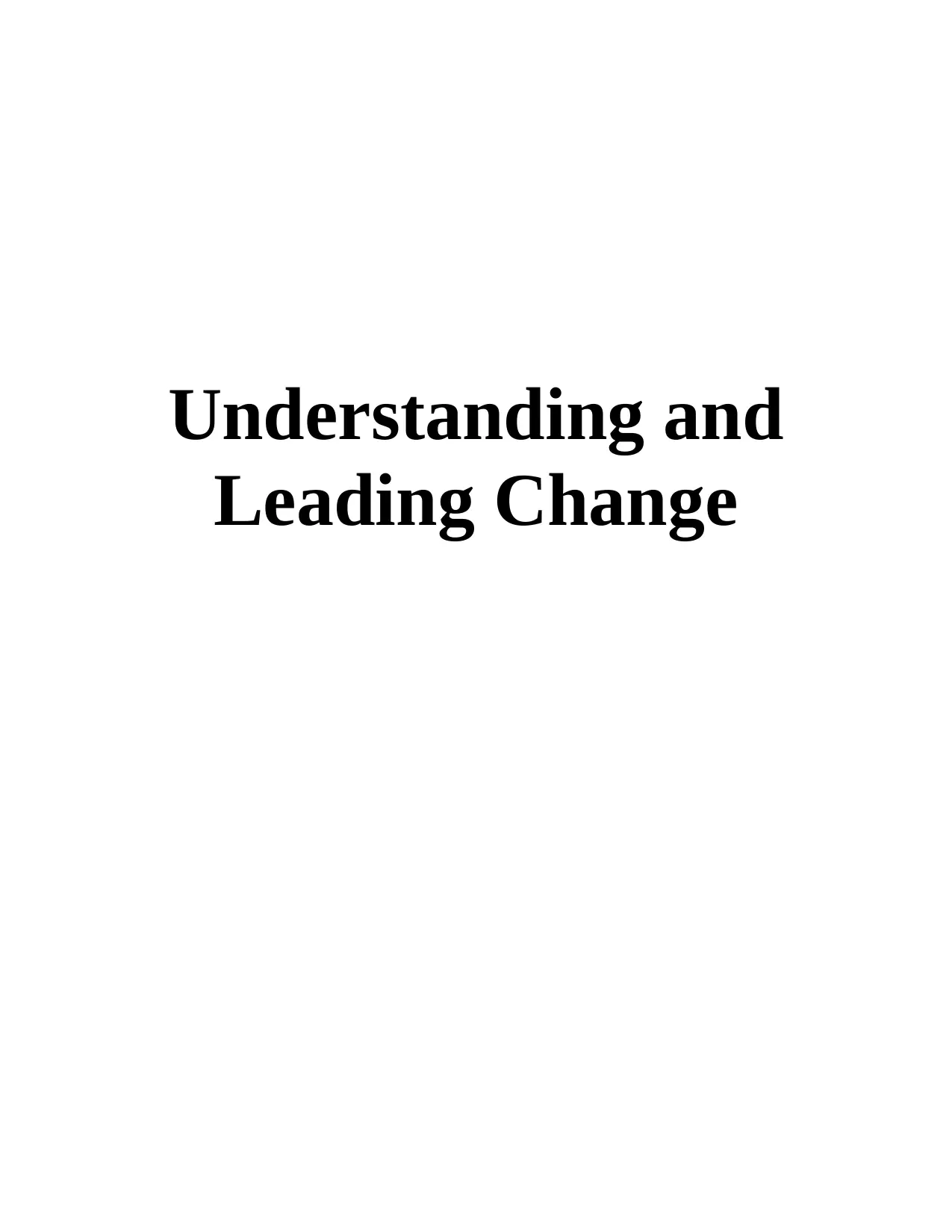
Understanding and
Leading Change
Leading Change
Paraphrase This Document
Need a fresh take? Get an instant paraphrase of this document with our AI Paraphraser
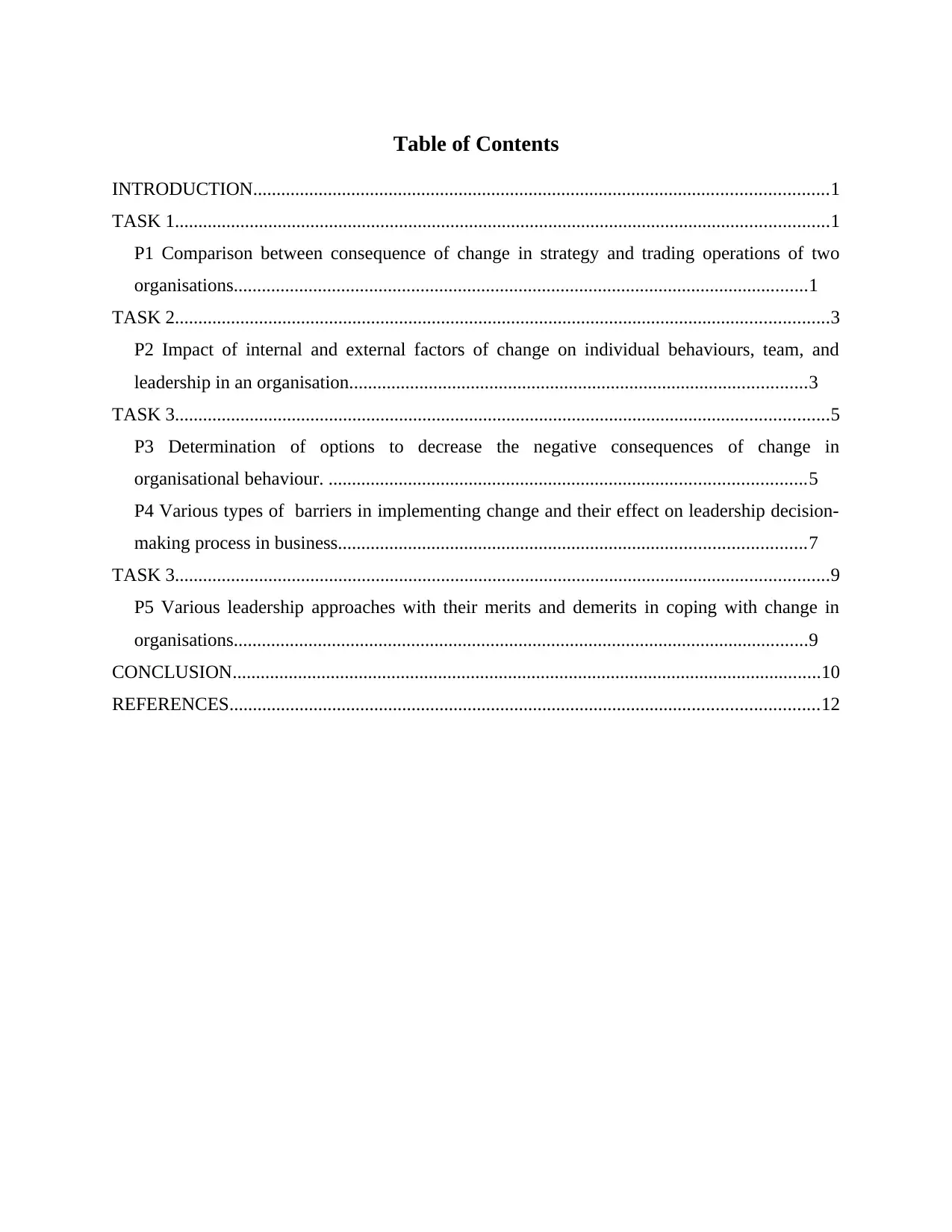
Table of Contents
INTRODUCTION...........................................................................................................................1
TASK 1............................................................................................................................................1
P1 Comparison between consequence of change in strategy and trading operations of two
organisations...........................................................................................................................1
TASK 2............................................................................................................................................3
P2 Impact of internal and external factors of change on individual behaviours, team, and
leadership in an organisation..................................................................................................3
TASK 3............................................................................................................................................5
P3 Determination of options to decrease the negative consequences of change in
organisational behaviour. ......................................................................................................5
P4 Various types of barriers in implementing change and their effect on leadership decision-
making process in business....................................................................................................7
TASK 3............................................................................................................................................9
P5 Various leadership approaches with their merits and demerits in coping with change in
organisations...........................................................................................................................9
CONCLUSION..............................................................................................................................10
REFERENCES..............................................................................................................................12
INTRODUCTION...........................................................................................................................1
TASK 1............................................................................................................................................1
P1 Comparison between consequence of change in strategy and trading operations of two
organisations...........................................................................................................................1
TASK 2............................................................................................................................................3
P2 Impact of internal and external factors of change on individual behaviours, team, and
leadership in an organisation..................................................................................................3
TASK 3............................................................................................................................................5
P3 Determination of options to decrease the negative consequences of change in
organisational behaviour. ......................................................................................................5
P4 Various types of barriers in implementing change and their effect on leadership decision-
making process in business....................................................................................................7
TASK 3............................................................................................................................................9
P5 Various leadership approaches with their merits and demerits in coping with change in
organisations...........................................................................................................................9
CONCLUSION..............................................................................................................................10
REFERENCES..............................................................................................................................12
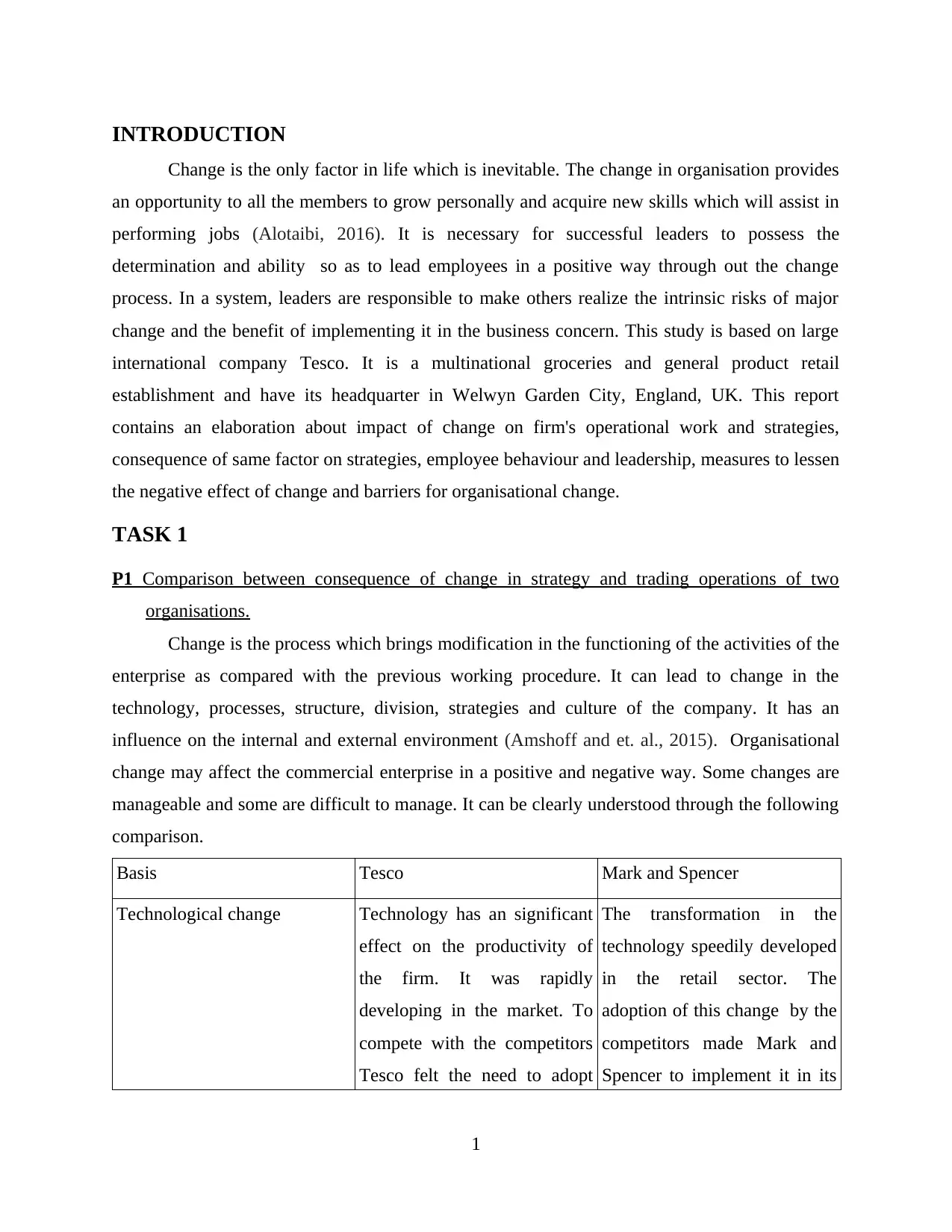
INTRODUCTION
Change is the only factor in life which is inevitable. The change in organisation provides
an opportunity to all the members to grow personally and acquire new skills which will assist in
performing jobs (Alotaibi, 2016). It is necessary for successful leaders to possess the
determination and ability so as to lead employees in a positive way through out the change
process. In a system, leaders are responsible to make others realize the intrinsic risks of major
change and the benefit of implementing it in the business concern. This study is based on large
international company Tesco. It is a multinational groceries and general product retail
establishment and have its headquarter in Welwyn Garden City, England, UK. This report
contains an elaboration about impact of change on firm's operational work and strategies,
consequence of same factor on strategies, employee behaviour and leadership, measures to lessen
the negative effect of change and barriers for organisational change.
TASK 1
P1 Comparison between consequence of change in strategy and trading operations of two
organisations.
Change is the process which brings modification in the functioning of the activities of the
enterprise as compared with the previous working procedure. It can lead to change in the
technology, processes, structure, division, strategies and culture of the company. It has an
influence on the internal and external environment (Amshoff and et. al., 2015). Organisational
change may affect the commercial enterprise in a positive and negative way. Some changes are
manageable and some are difficult to manage. It can be clearly understood through the following
comparison.
Basis Tesco Mark and Spencer
Technological change Technology has an significant
effect on the productivity of
the firm. It was rapidly
developing in the market. To
compete with the competitors
Tesco felt the need to adopt
The transformation in the
technology speedily developed
in the retail sector. The
adoption of this change by the
competitors made Mark and
Spencer to implement it in its
1
Change is the only factor in life which is inevitable. The change in organisation provides
an opportunity to all the members to grow personally and acquire new skills which will assist in
performing jobs (Alotaibi, 2016). It is necessary for successful leaders to possess the
determination and ability so as to lead employees in a positive way through out the change
process. In a system, leaders are responsible to make others realize the intrinsic risks of major
change and the benefit of implementing it in the business concern. This study is based on large
international company Tesco. It is a multinational groceries and general product retail
establishment and have its headquarter in Welwyn Garden City, England, UK. This report
contains an elaboration about impact of change on firm's operational work and strategies,
consequence of same factor on strategies, employee behaviour and leadership, measures to lessen
the negative effect of change and barriers for organisational change.
TASK 1
P1 Comparison between consequence of change in strategy and trading operations of two
organisations.
Change is the process which brings modification in the functioning of the activities of the
enterprise as compared with the previous working procedure. It can lead to change in the
technology, processes, structure, division, strategies and culture of the company. It has an
influence on the internal and external environment (Amshoff and et. al., 2015). Organisational
change may affect the commercial enterprise in a positive and negative way. Some changes are
manageable and some are difficult to manage. It can be clearly understood through the following
comparison.
Basis Tesco Mark and Spencer
Technological change Technology has an significant
effect on the productivity of
the firm. It was rapidly
developing in the market. To
compete with the competitors
Tesco felt the need to adopt
The transformation in the
technology speedily developed
in the retail sector. The
adoption of this change by the
competitors made Mark and
Spencer to implement it in its
1
⊘ This is a preview!⊘
Do you want full access?
Subscribe today to unlock all pages.

Trusted by 1+ million students worldwide

new technologies.
It has instigated new RFID-
modified barcode to simplify
the process of counting of
stocks.
Tesco has provided BYOD
integration app only for the
employees to keep record of
stock levels and availability of
product in the stores.
To use this technology
efficiently the firm provided
training to the staffs of stock
department.
functioning.
The company has created a
new technological operating
model with the implementation
of industry agile method to
improve the business and
increase the customers.
It has innovated the 'digital lab'
to keep an eye on the speedy
occurrence of technological
change in the retail sector.
Mark and Spencer improved
the performance of the
employees by incorporating
the technical skills in
employees.
Structural change The ineffective
communication system caused
to perform structural change in
Tesco.
It has done recent changes in
the operational structure in
order to improve efficiency in
communication among the
employees and enable direct
communication with the
customers. This change will
help in removing the
complexities in business.
The delays in the decisions
taken in the Mark and Spencer
affected the outcome and lead
to this type of change in the
company.
It has implemented changes in
the management structure of
the company to simplify the
structure and improve the
decision making process and
take the concern closer to
customers.
2
It has instigated new RFID-
modified barcode to simplify
the process of counting of
stocks.
Tesco has provided BYOD
integration app only for the
employees to keep record of
stock levels and availability of
product in the stores.
To use this technology
efficiently the firm provided
training to the staffs of stock
department.
functioning.
The company has created a
new technological operating
model with the implementation
of industry agile method to
improve the business and
increase the customers.
It has innovated the 'digital lab'
to keep an eye on the speedy
occurrence of technological
change in the retail sector.
Mark and Spencer improved
the performance of the
employees by incorporating
the technical skills in
employees.
Structural change The ineffective
communication system caused
to perform structural change in
Tesco.
It has done recent changes in
the operational structure in
order to improve efficiency in
communication among the
employees and enable direct
communication with the
customers. This change will
help in removing the
complexities in business.
The delays in the decisions
taken in the Mark and Spencer
affected the outcome and lead
to this type of change in the
company.
It has implemented changes in
the management structure of
the company to simplify the
structure and improve the
decision making process and
take the concern closer to
customers.
2
Paraphrase This Document
Need a fresh take? Get an instant paraphrase of this document with our AI Paraphraser
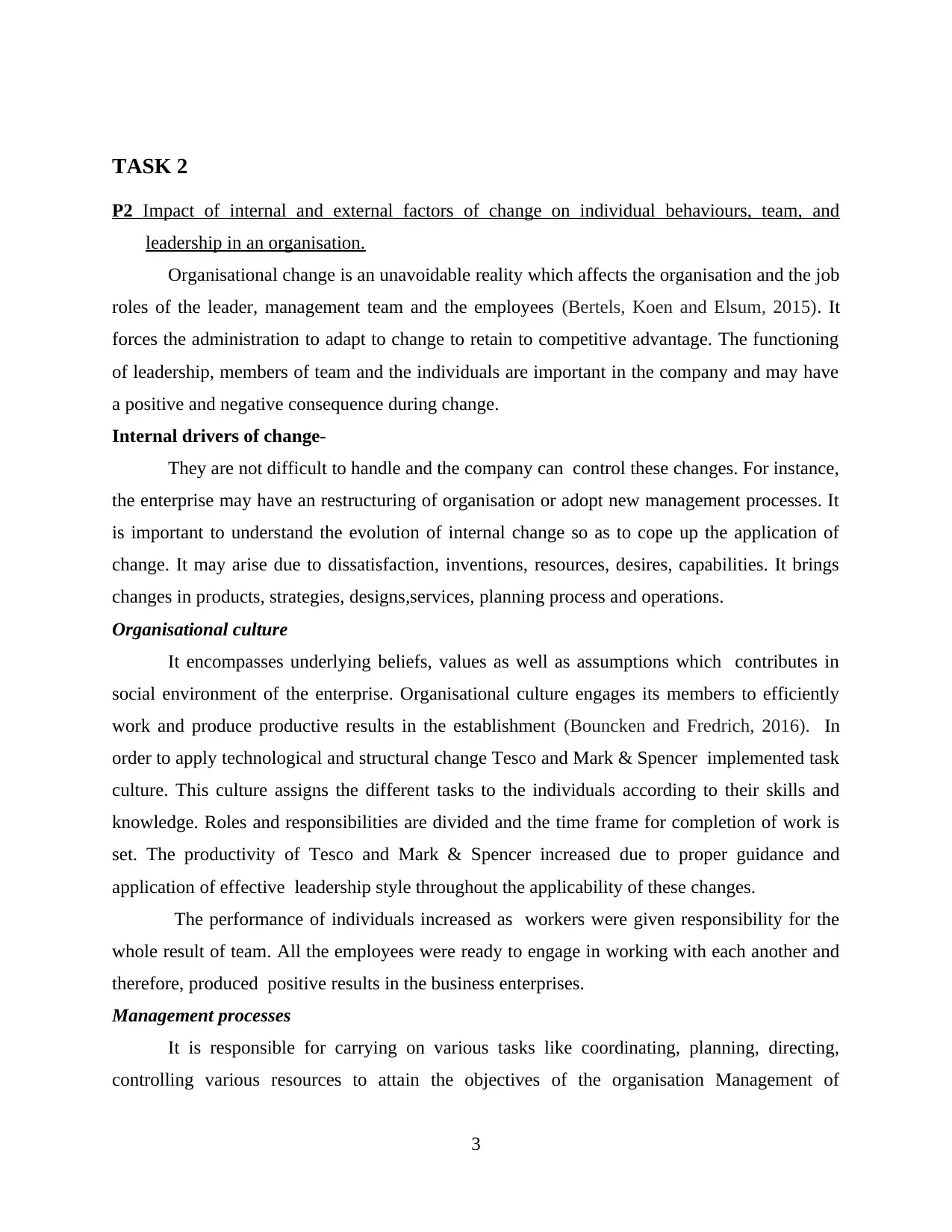
TASK 2
P2 Impact of internal and external factors of change on individual behaviours, team, and
leadership in an organisation.
Organisational change is an unavoidable reality which affects the organisation and the job
roles of the leader, management team and the employees (Bertels, Koen and Elsum, 2015). It
forces the administration to adapt to change to retain to competitive advantage. The functioning
of leadership, members of team and the individuals are important in the company and may have
a positive and negative consequence during change.
Internal drivers of change-
They are not difficult to handle and the company can control these changes. For instance,
the enterprise may have an restructuring of organisation or adopt new management processes. It
is important to understand the evolution of internal change so as to cope up the application of
change. It may arise due to dissatisfaction, inventions, resources, desires, capabilities. It brings
changes in products, strategies, designs,services, planning process and operations.
Organisational culture
It encompasses underlying beliefs, values as well as assumptions which contributes in
social environment of the enterprise. Organisational culture engages its members to efficiently
work and produce productive results in the establishment (Bouncken and Fredrich, 2016). In
order to apply technological and structural change Tesco and Mark & Spencer implemented task
culture. This culture assigns the different tasks to the individuals according to their skills and
knowledge. Roles and responsibilities are divided and the time frame for completion of work is
set. The productivity of Tesco and Mark & Spencer increased due to proper guidance and
application of effective leadership style throughout the applicability of these changes.
The performance of individuals increased as workers were given responsibility for the
whole result of team. All the employees were ready to engage in working with each another and
therefore, produced positive results in the business enterprises.
Management processes
It is responsible for carrying on various tasks like coordinating, planning, directing,
controlling various resources to attain the objectives of the organisation Management of
3
P2 Impact of internal and external factors of change on individual behaviours, team, and
leadership in an organisation.
Organisational change is an unavoidable reality which affects the organisation and the job
roles of the leader, management team and the employees (Bertels, Koen and Elsum, 2015). It
forces the administration to adapt to change to retain to competitive advantage. The functioning
of leadership, members of team and the individuals are important in the company and may have
a positive and negative consequence during change.
Internal drivers of change-
They are not difficult to handle and the company can control these changes. For instance,
the enterprise may have an restructuring of organisation or adopt new management processes. It
is important to understand the evolution of internal change so as to cope up the application of
change. It may arise due to dissatisfaction, inventions, resources, desires, capabilities. It brings
changes in products, strategies, designs,services, planning process and operations.
Organisational culture
It encompasses underlying beliefs, values as well as assumptions which contributes in
social environment of the enterprise. Organisational culture engages its members to efficiently
work and produce productive results in the establishment (Bouncken and Fredrich, 2016). In
order to apply technological and structural change Tesco and Mark & Spencer implemented task
culture. This culture assigns the different tasks to the individuals according to their skills and
knowledge. Roles and responsibilities are divided and the time frame for completion of work is
set. The productivity of Tesco and Mark & Spencer increased due to proper guidance and
application of effective leadership style throughout the applicability of these changes.
The performance of individuals increased as workers were given responsibility for the
whole result of team. All the employees were ready to engage in working with each another and
therefore, produced positive results in the business enterprises.
Management processes
It is responsible for carrying on various tasks like coordinating, planning, directing,
controlling various resources to attain the objectives of the organisation Management of
3

administration is crucial as it involves individuals who are engaged in operative style and
administration of operations in effective manner. For effectively applying structural and
technological change in Tesco and Mark & Spencer, both applied the organisational structure
type of hierarchical and therefore communication takes place in downward flow. It is effective
structure. It enabled the proper flow of communication. It enhanced the behaviour and attitude of
the workforce.
Types of changes in the business Transformational change - Transformational changes are termed to be those changes
that can create to complete and execute the form and the managerial tactics and process
as frequently in maintaining in work culture. Such sort of changes would be relates to the
reply of high and and unexpected organisational changes. Transformation changes can
develop fear, doubt and anxiety in an individual and needs that are to be managed. Developmental change – Developmental variations are those changes that can increase
the current organisational procedure. As the staff faculty understands the section to
informed of changes and offers them the training that they need to be implemented the
process that they should experience lower term of stress from developing changes.
Transitional change - Transitional changes are those variations that can create to replace
current process with new process. Transitional variations is more difficult to implement
and can increase the candidates condition.
The management process provided positive outcome and helped in building healthy
working in the company (Bucero and Englund, 2015). This structure allotted particular
responsibilities and function to all the employees. Hence, it helped the leader to perform
effectual leadership in appropriate situations. All the activities were carried on smoothly by the
team members with better communication and therefore the leadership was positive.
External drivers of change-
These refers to components like competition, economics, technology, customers, politics
and legislation. They are difficult to handle and the firm cannot have control over it (Bujari and
et. al., 2018).The company can keep record of these drivers of change by the scanning the
external environment.
The drivers of change can be recognised with the help of the following Pestel Analysis:
Pestel analysis :-
4
administration of operations in effective manner. For effectively applying structural and
technological change in Tesco and Mark & Spencer, both applied the organisational structure
type of hierarchical and therefore communication takes place in downward flow. It is effective
structure. It enabled the proper flow of communication. It enhanced the behaviour and attitude of
the workforce.
Types of changes in the business Transformational change - Transformational changes are termed to be those changes
that can create to complete and execute the form and the managerial tactics and process
as frequently in maintaining in work culture. Such sort of changes would be relates to the
reply of high and and unexpected organisational changes. Transformation changes can
develop fear, doubt and anxiety in an individual and needs that are to be managed. Developmental change – Developmental variations are those changes that can increase
the current organisational procedure. As the staff faculty understands the section to
informed of changes and offers them the training that they need to be implemented the
process that they should experience lower term of stress from developing changes.
Transitional change - Transitional changes are those variations that can create to replace
current process with new process. Transitional variations is more difficult to implement
and can increase the candidates condition.
The management process provided positive outcome and helped in building healthy
working in the company (Bucero and Englund, 2015). This structure allotted particular
responsibilities and function to all the employees. Hence, it helped the leader to perform
effectual leadership in appropriate situations. All the activities were carried on smoothly by the
team members with better communication and therefore the leadership was positive.
External drivers of change-
These refers to components like competition, economics, technology, customers, politics
and legislation. They are difficult to handle and the firm cannot have control over it (Bujari and
et. al., 2018).The company can keep record of these drivers of change by the scanning the
external environment.
The drivers of change can be recognised with the help of the following Pestel Analysis:
Pestel analysis :-
4
⊘ This is a preview!⊘
Do you want full access?
Subscribe today to unlock all pages.

Trusted by 1+ million students worldwide
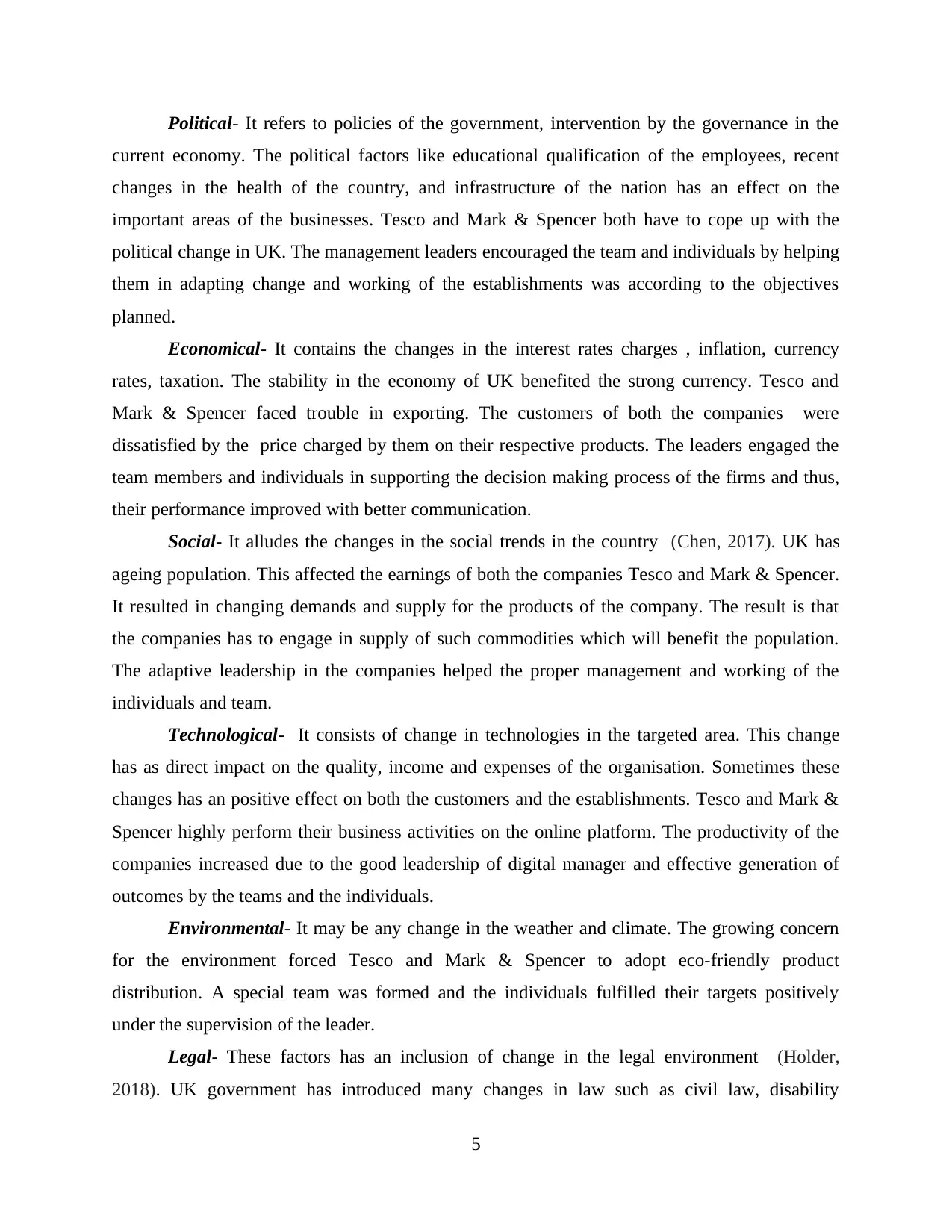
Political- It refers to policies of the government, intervention by the governance in the
current economy. The political factors like educational qualification of the employees, recent
changes in the health of the country, and infrastructure of the nation has an effect on the
important areas of the businesses. Tesco and Mark & Spencer both have to cope up with the
political change in UK. The management leaders encouraged the team and individuals by helping
them in adapting change and working of the establishments was according to the objectives
planned.
Economical- It contains the changes in the interest rates charges , inflation, currency
rates, taxation. The stability in the economy of UK benefited the strong currency. Tesco and
Mark & Spencer faced trouble in exporting. The customers of both the companies were
dissatisfied by the price charged by them on their respective products. The leaders engaged the
team members and individuals in supporting the decision making process of the firms and thus,
their performance improved with better communication.
Social- It alludes the changes in the social trends in the country (Chen, 2017). UK has
ageing population. This affected the earnings of both the companies Tesco and Mark & Spencer.
It resulted in changing demands and supply for the products of the company. The result is that
the companies has to engage in supply of such commodities which will benefit the population.
The adaptive leadership in the companies helped the proper management and working of the
individuals and team.
Technological- It consists of change in technologies in the targeted area. This change
has as direct impact on the quality, income and expenses of the organisation. Sometimes these
changes has an positive effect on both the customers and the establishments. Tesco and Mark &
Spencer highly perform their business activities on the online platform. The productivity of the
companies increased due to the good leadership of digital manager and effective generation of
outcomes by the teams and the individuals.
Environmental- It may be any change in the weather and climate. The growing concern
for the environment forced Tesco and Mark & Spencer to adopt eco-friendly product
distribution. A special team was formed and the individuals fulfilled their targets positively
under the supervision of the leader.
Legal- These factors has an inclusion of change in the legal environment (Holder,
2018). UK government has introduced many changes in law such as civil law, disability
5
current economy. The political factors like educational qualification of the employees, recent
changes in the health of the country, and infrastructure of the nation has an effect on the
important areas of the businesses. Tesco and Mark & Spencer both have to cope up with the
political change in UK. The management leaders encouraged the team and individuals by helping
them in adapting change and working of the establishments was according to the objectives
planned.
Economical- It contains the changes in the interest rates charges , inflation, currency
rates, taxation. The stability in the economy of UK benefited the strong currency. Tesco and
Mark & Spencer faced trouble in exporting. The customers of both the companies were
dissatisfied by the price charged by them on their respective products. The leaders engaged the
team members and individuals in supporting the decision making process of the firms and thus,
their performance improved with better communication.
Social- It alludes the changes in the social trends in the country (Chen, 2017). UK has
ageing population. This affected the earnings of both the companies Tesco and Mark & Spencer.
It resulted in changing demands and supply for the products of the company. The result is that
the companies has to engage in supply of such commodities which will benefit the population.
The adaptive leadership in the companies helped the proper management and working of the
individuals and team.
Technological- It consists of change in technologies in the targeted area. This change
has as direct impact on the quality, income and expenses of the organisation. Sometimes these
changes has an positive effect on both the customers and the establishments. Tesco and Mark &
Spencer highly perform their business activities on the online platform. The productivity of the
companies increased due to the good leadership of digital manager and effective generation of
outcomes by the teams and the individuals.
Environmental- It may be any change in the weather and climate. The growing concern
for the environment forced Tesco and Mark & Spencer to adopt eco-friendly product
distribution. A special team was formed and the individuals fulfilled their targets positively
under the supervision of the leader.
Legal- These factors has an inclusion of change in the legal environment (Holder,
2018). UK government has introduced many changes in law such as civil law, disability
5
Paraphrase This Document
Need a fresh take? Get an instant paraphrase of this document with our AI Paraphraser

discrimination, minimum wage requirements, age favouritism factors. These all changes affected
the Tesco and Mark & Spencer's establishment's costs and buying behaviour of the company's
customers. The leaders motivated the performance of team and individuals by complying with
the change.
Competitors - Globalisation has maximise the challenges, innovation, technologies, new
management. As new management creative new thoughts and techniques that are being utilised
by new challengers that are developed more challengers for other present business because their
machine, technologies are related with the divisions that can't replace it.
Technological Capacity - The section of new techniques can make the old one outdated.
As it is important for the business to hold their information with the technical variations because
they need essential aspects that aid the business functions in long lasting manner.
TASK 3
P3 Determination of options to decrease the negative consequences of change in organisational
behaviour.
Tesco can use the PDCA cycle so as to lessen the negative consequences of change on
the establishment's behaviour.
PDCA Cycle-
This cycle consists of four stages which helps in the continuous improvement of the
processes of the businesses. It is also known as repetitive model which is repeated until the final
improvement is achieved (Hornstein, 2015). This model helps in implementing the change in the
organisation.
6
the Tesco and Mark & Spencer's establishment's costs and buying behaviour of the company's
customers. The leaders motivated the performance of team and individuals by complying with
the change.
Competitors - Globalisation has maximise the challenges, innovation, technologies, new
management. As new management creative new thoughts and techniques that are being utilised
by new challengers that are developed more challengers for other present business because their
machine, technologies are related with the divisions that can't replace it.
Technological Capacity - The section of new techniques can make the old one outdated.
As it is important for the business to hold their information with the technical variations because
they need essential aspects that aid the business functions in long lasting manner.
TASK 3
P3 Determination of options to decrease the negative consequences of change in organisational
behaviour.
Tesco can use the PDCA cycle so as to lessen the negative consequences of change on
the establishment's behaviour.
PDCA Cycle-
This cycle consists of four stages which helps in the continuous improvement of the
processes of the businesses. It is also known as repetitive model which is repeated until the final
improvement is achieved (Hornstein, 2015). This model helps in implementing the change in the
organisation.
6
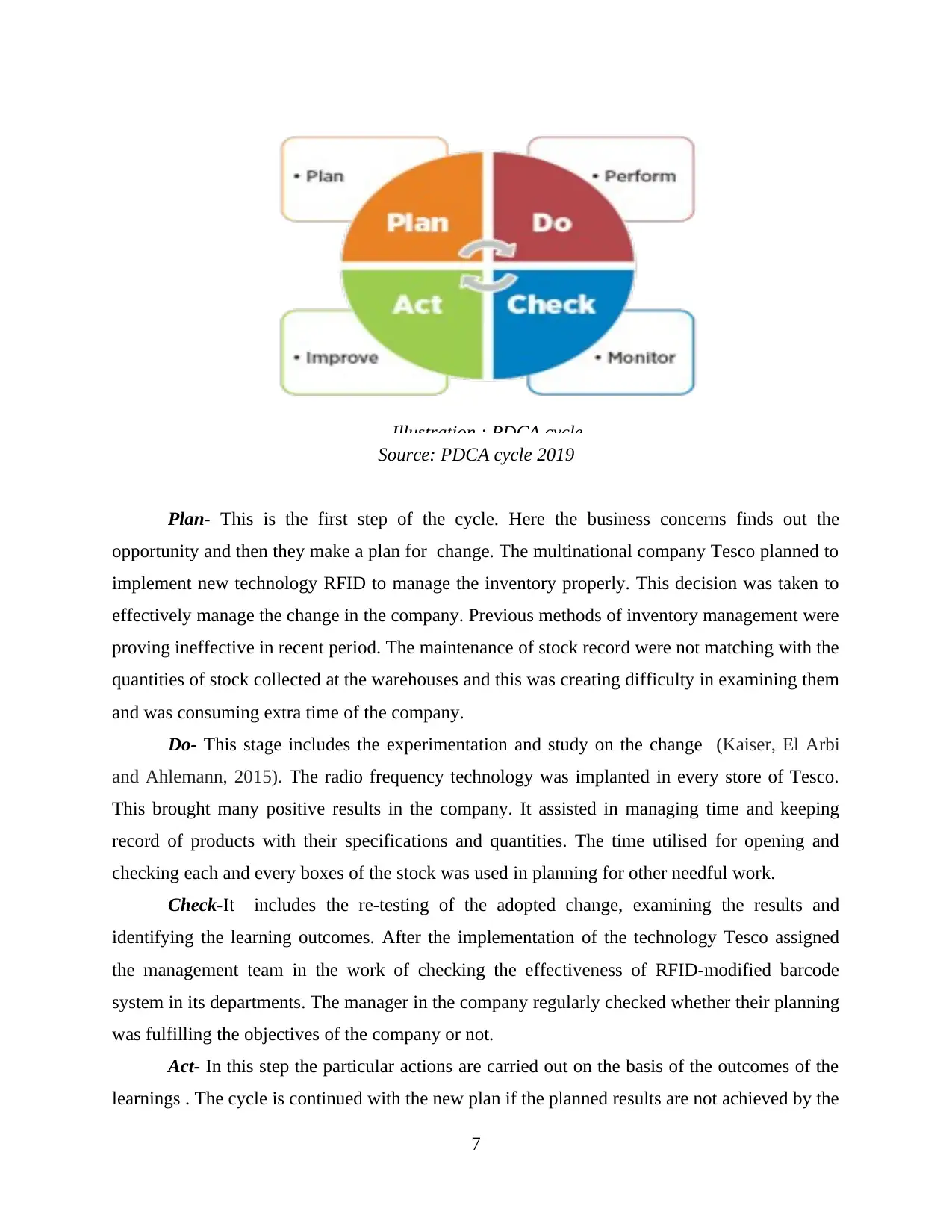
Source: PDCA cycle 2019
Plan- This is the first step of the cycle. Here the business concerns finds out the
opportunity and then they make a plan for change. The multinational company Tesco planned to
implement new technology RFID to manage the inventory properly. This decision was taken to
effectively manage the change in the company. Previous methods of inventory management were
proving ineffective in recent period. The maintenance of stock record were not matching with the
quantities of stock collected at the warehouses and this was creating difficulty in examining them
and was consuming extra time of the company.
Do- This stage includes the experimentation and study on the change (Kaiser, El Arbi
and Ahlemann, 2015). The radio frequency technology was implanted in every store of Tesco.
This brought many positive results in the company. It assisted in managing time and keeping
record of products with their specifications and quantities. The time utilised for opening and
checking each and every boxes of the stock was used in planning for other needful work.
Check-It includes the re-testing of the adopted change, examining the results and
identifying the learning outcomes. After the implementation of the technology Tesco assigned
the management team in the work of checking the effectiveness of RFID-modified barcode
system in its departments. The manager in the company regularly checked whether their planning
was fulfilling the objectives of the company or not.
Act- In this step the particular actions are carried out on the basis of the outcomes of the
learnings . The cycle is continued with the new plan if the planned results are not achieved by the
7
Illustration : PDCA cycle
Plan- This is the first step of the cycle. Here the business concerns finds out the
opportunity and then they make a plan for change. The multinational company Tesco planned to
implement new technology RFID to manage the inventory properly. This decision was taken to
effectively manage the change in the company. Previous methods of inventory management were
proving ineffective in recent period. The maintenance of stock record were not matching with the
quantities of stock collected at the warehouses and this was creating difficulty in examining them
and was consuming extra time of the company.
Do- This stage includes the experimentation and study on the change (Kaiser, El Arbi
and Ahlemann, 2015). The radio frequency technology was implanted in every store of Tesco.
This brought many positive results in the company. It assisted in managing time and keeping
record of products with their specifications and quantities. The time utilised for opening and
checking each and every boxes of the stock was used in planning for other needful work.
Check-It includes the re-testing of the adopted change, examining the results and
identifying the learning outcomes. After the implementation of the technology Tesco assigned
the management team in the work of checking the effectiveness of RFID-modified barcode
system in its departments. The manager in the company regularly checked whether their planning
was fulfilling the objectives of the company or not.
Act- In this step the particular actions are carried out on the basis of the outcomes of the
learnings . The cycle is continued with the new plan if the planned results are not achieved by the
7
Illustration : PDCA cycle
⊘ This is a preview!⊘
Do you want full access?
Subscribe today to unlock all pages.

Trusted by 1+ million students worldwide
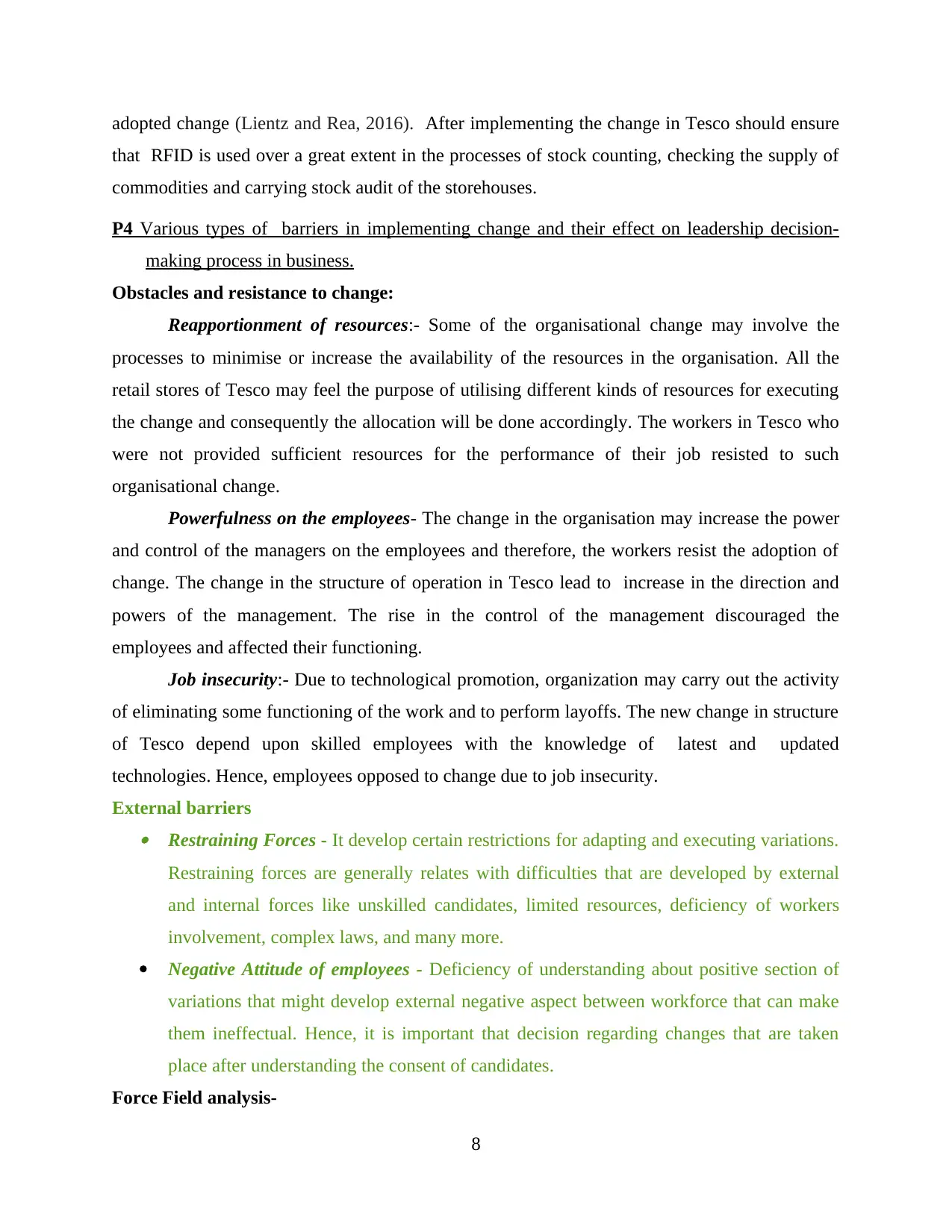
adopted change (Lientz and Rea, 2016). After implementing the change in Tesco should ensure
that RFID is used over a great extent in the processes of stock counting, checking the supply of
commodities and carrying stock audit of the storehouses.
P4 Various types of barriers in implementing change and their effect on leadership decision-
making process in business.
Obstacles and resistance to change:
Reapportionment of resources:- Some of the organisational change may involve the
processes to minimise or increase the availability of the resources in the organisation. All the
retail stores of Tesco may feel the purpose of utilising different kinds of resources for executing
the change and consequently the allocation will be done accordingly. The workers in Tesco who
were not provided sufficient resources for the performance of their job resisted to such
organisational change.
Powerfulness on the employees- The change in the organisation may increase the power
and control of the managers on the employees and therefore, the workers resist the adoption of
change. The change in the structure of operation in Tesco lead to increase in the direction and
powers of the management. The rise in the control of the management discouraged the
employees and affected their functioning.
Job insecurity:- Due to technological promotion, organization may carry out the activity
of eliminating some functioning of the work and to perform layoffs. The new change in structure
of Tesco depend upon skilled employees with the knowledge of latest and updated
technologies. Hence, employees opposed to change due to job insecurity.
External barriers Restraining Forces - It develop certain restrictions for adapting and executing variations.
Restraining forces are generally relates with difficulties that are developed by external
and internal forces like unskilled candidates, limited resources, deficiency of workers
involvement, complex laws, and many more.
Negative Attitude of employees - Deficiency of understanding about positive section of
variations that might develop external negative aspect between workforce that can make
them ineffectual. Hence, it is important that decision regarding changes that are taken
place after understanding the consent of candidates.
Force Field analysis-
8
that RFID is used over a great extent in the processes of stock counting, checking the supply of
commodities and carrying stock audit of the storehouses.
P4 Various types of barriers in implementing change and their effect on leadership decision-
making process in business.
Obstacles and resistance to change:
Reapportionment of resources:- Some of the organisational change may involve the
processes to minimise or increase the availability of the resources in the organisation. All the
retail stores of Tesco may feel the purpose of utilising different kinds of resources for executing
the change and consequently the allocation will be done accordingly. The workers in Tesco who
were not provided sufficient resources for the performance of their job resisted to such
organisational change.
Powerfulness on the employees- The change in the organisation may increase the power
and control of the managers on the employees and therefore, the workers resist the adoption of
change. The change in the structure of operation in Tesco lead to increase in the direction and
powers of the management. The rise in the control of the management discouraged the
employees and affected their functioning.
Job insecurity:- Due to technological promotion, organization may carry out the activity
of eliminating some functioning of the work and to perform layoffs. The new change in structure
of Tesco depend upon skilled employees with the knowledge of latest and updated
technologies. Hence, employees opposed to change due to job insecurity.
External barriers Restraining Forces - It develop certain restrictions for adapting and executing variations.
Restraining forces are generally relates with difficulties that are developed by external
and internal forces like unskilled candidates, limited resources, deficiency of workers
involvement, complex laws, and many more.
Negative Attitude of employees - Deficiency of understanding about positive section of
variations that might develop external negative aspect between workforce that can make
them ineffectual. Hence, it is important that decision regarding changes that are taken
place after understanding the consent of candidates.
Force Field analysis-
8
Paraphrase This Document
Need a fresh take? Get an instant paraphrase of this document with our AI Paraphraser
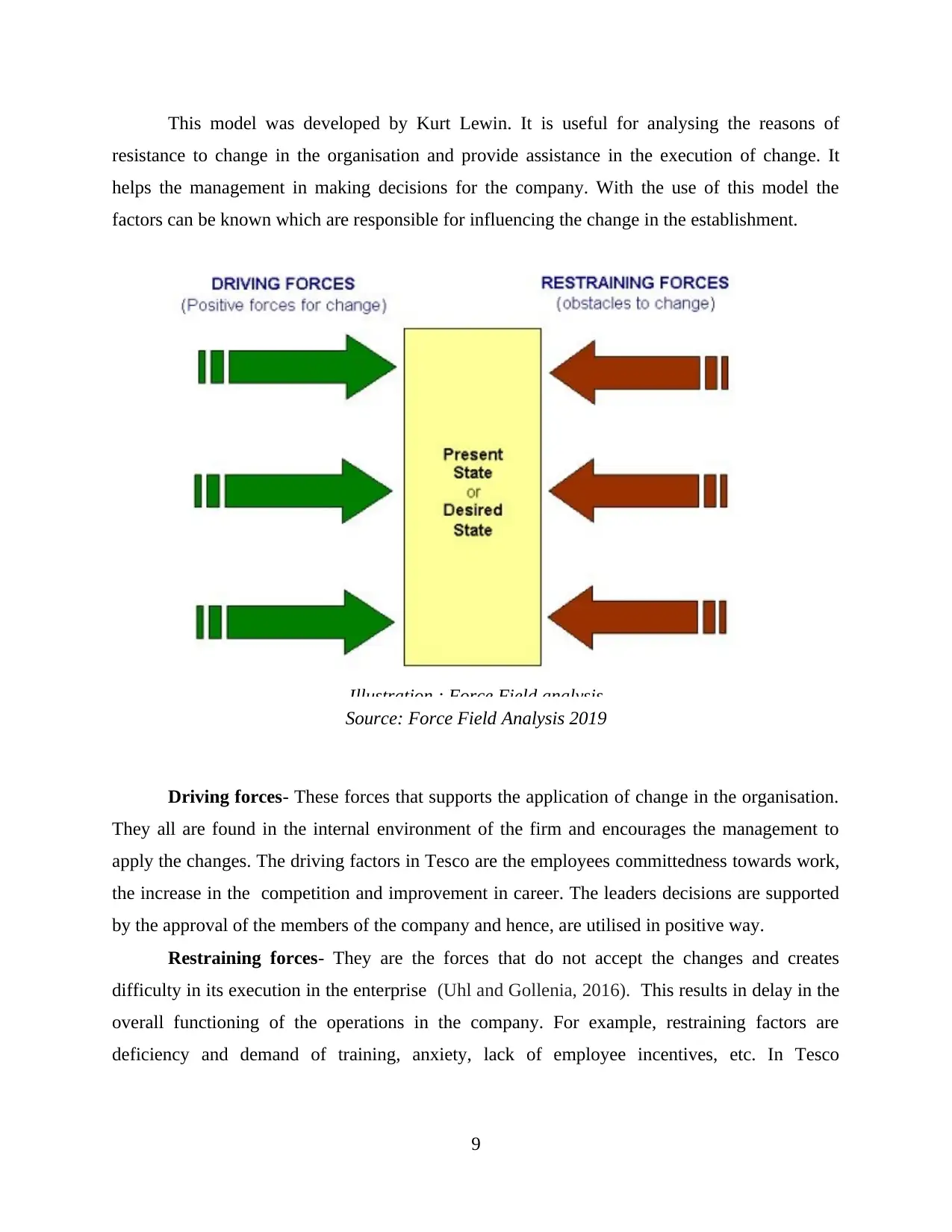
This model was developed by Kurt Lewin. It is useful for analysing the reasons of
resistance to change in the organisation and provide assistance in the execution of change. It
helps the management in making decisions for the company. With the use of this model the
factors can be known which are responsible for influencing the change in the establishment.
Source: Force Field Analysis 2019
Driving forces- These forces that supports the application of change in the organisation.
They all are found in the internal environment of the firm and encourages the management to
apply the changes. The driving factors in Tesco are the employees committedness towards work,
the increase in the competition and improvement in career. The leaders decisions are supported
by the approval of the members of the company and hence, are utilised in positive way.
Restraining forces- They are the forces that do not accept the changes and creates
difficulty in its execution in the enterprise (Uhl and Gollenia, 2016). This results in delay in the
overall functioning of the operations in the company. For example, restraining factors are
deficiency and demand of training, anxiety, lack of employee incentives, etc. In Tesco
9
Illustration : Force Field analysis
resistance to change in the organisation and provide assistance in the execution of change. It
helps the management in making decisions for the company. With the use of this model the
factors can be known which are responsible for influencing the change in the establishment.
Source: Force Field Analysis 2019
Driving forces- These forces that supports the application of change in the organisation.
They all are found in the internal environment of the firm and encourages the management to
apply the changes. The driving factors in Tesco are the employees committedness towards work,
the increase in the competition and improvement in career. The leaders decisions are supported
by the approval of the members of the company and hence, are utilised in positive way.
Restraining forces- They are the forces that do not accept the changes and creates
difficulty in its execution in the enterprise (Uhl and Gollenia, 2016). This results in delay in the
overall functioning of the operations in the company. For example, restraining factors are
deficiency and demand of training, anxiety, lack of employee incentives, etc. In Tesco
9
Illustration : Force Field analysis

employees opposed the structural change due to fear of losing power and get dominated by the
managers. It created hurdles in the decision making procedure of the leaders.
Utilisation of Force Field Analysis -The managers of Tesco made the use of this model in
managing change and get better understanding of procedures concerned with management of
organisational change. It consists of five stages as mentioned below:-
Change matter: The management of Tesco examined the necessity of changes and
therefore made detailed analysis of present environment of market with the uasge of efficacious
techniques. The management team understood the pertaining condition and thereby made plan
for determining the future changes.
Distinguishing changing forces: In this step various forces that may be restraining and
driving are verified and determined with the identification of various risks and challenges by
applying proper strategies. The managing director of Tesco developed such useful strategies that
they can be used in verifying the characteristic of change forces.
Determination of forces which are not in favour of alterations: Tesco identified and
made evaluation of different alternative features which did not favoured change and made
appropriate decision so as to select suitable option that will aid in getting advantageous benefits
for future.
Score assigning: Tesco management assigned scores to designated alternatives and
thereby made further modifications consequently to gain maximum profit.
Evaluation and execution: Tesco evaluated the useful changes and implemented plans
so as to attain the success and continuous growth in business.
TASK 3
P5 Various leadership approaches with their merits and demerits in coping with change in
organisations.
In the organisation whenever the change is commenced the leaders get more control,
time and opportunity. Hence, a leader can select the best approach in order to apply in the
concern. The various types of leadership approaches with their advantages and disadvantages are
described below:
Autocratic leadership- In this type of approach the power to run company is allotted to
one person only, who may be a manager, business operator or leader. It assists the leader in
10
managers. It created hurdles in the decision making procedure of the leaders.
Utilisation of Force Field Analysis -The managers of Tesco made the use of this model in
managing change and get better understanding of procedures concerned with management of
organisational change. It consists of five stages as mentioned below:-
Change matter: The management of Tesco examined the necessity of changes and
therefore made detailed analysis of present environment of market with the uasge of efficacious
techniques. The management team understood the pertaining condition and thereby made plan
for determining the future changes.
Distinguishing changing forces: In this step various forces that may be restraining and
driving are verified and determined with the identification of various risks and challenges by
applying proper strategies. The managing director of Tesco developed such useful strategies that
they can be used in verifying the characteristic of change forces.
Determination of forces which are not in favour of alterations: Tesco identified and
made evaluation of different alternative features which did not favoured change and made
appropriate decision so as to select suitable option that will aid in getting advantageous benefits
for future.
Score assigning: Tesco management assigned scores to designated alternatives and
thereby made further modifications consequently to gain maximum profit.
Evaluation and execution: Tesco evaluated the useful changes and implemented plans
so as to attain the success and continuous growth in business.
TASK 3
P5 Various leadership approaches with their merits and demerits in coping with change in
organisations.
In the organisation whenever the change is commenced the leaders get more control,
time and opportunity. Hence, a leader can select the best approach in order to apply in the
concern. The various types of leadership approaches with their advantages and disadvantages are
described below:
Autocratic leadership- In this type of approach the power to run company is allotted to
one person only, who may be a manager, business operator or leader. It assists the leader in
10
⊘ This is a preview!⊘
Do you want full access?
Subscribe today to unlock all pages.

Trusted by 1+ million students worldwide
1 out of 16
Related Documents
Your All-in-One AI-Powered Toolkit for Academic Success.
+13062052269
info@desklib.com
Available 24*7 on WhatsApp / Email
![[object Object]](/_next/static/media/star-bottom.7253800d.svg)
Unlock your academic potential
Copyright © 2020–2025 A2Z Services. All Rights Reserved. Developed and managed by ZUCOL.




